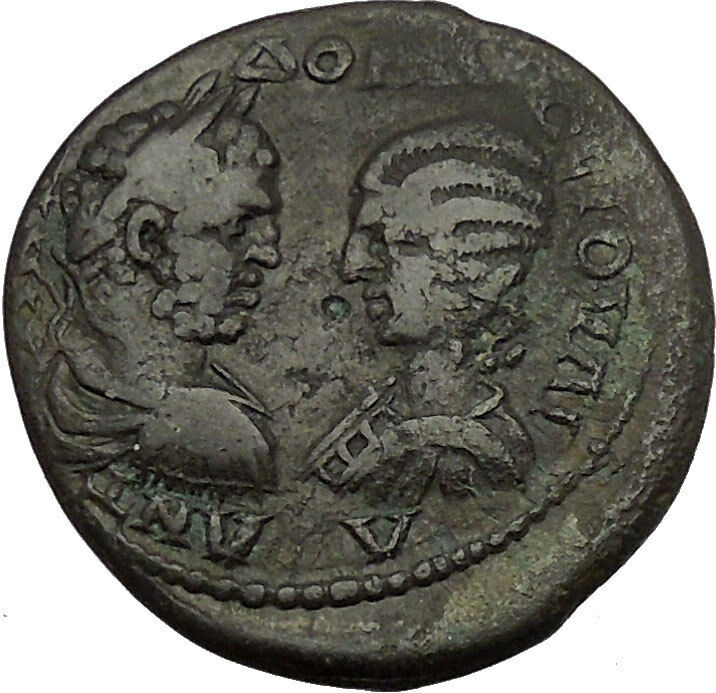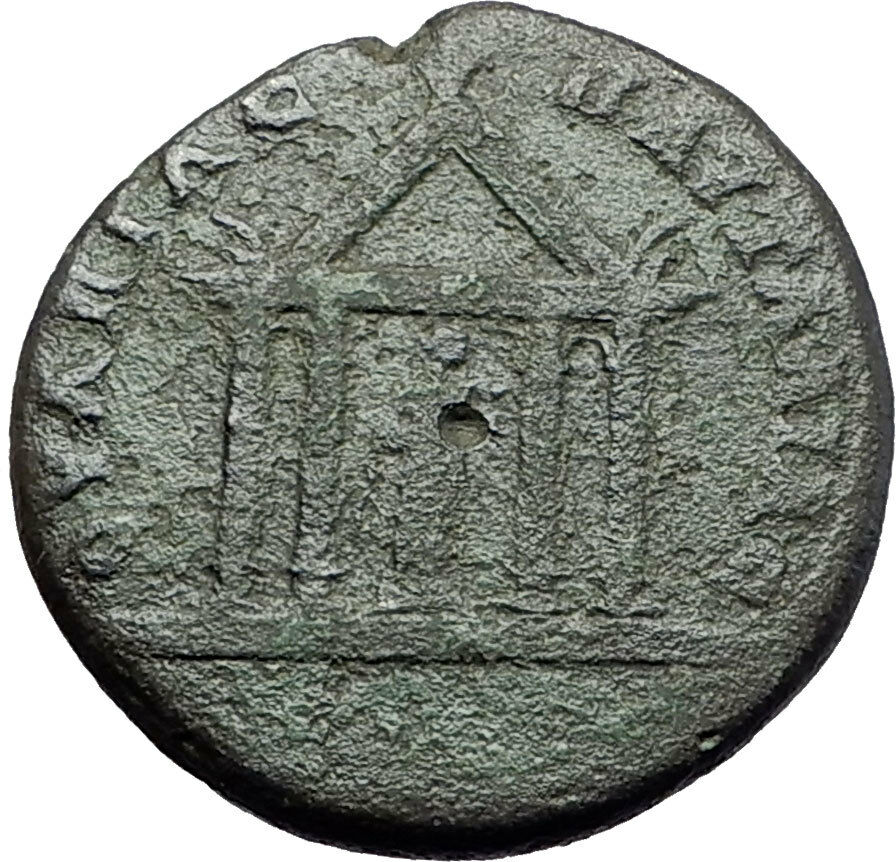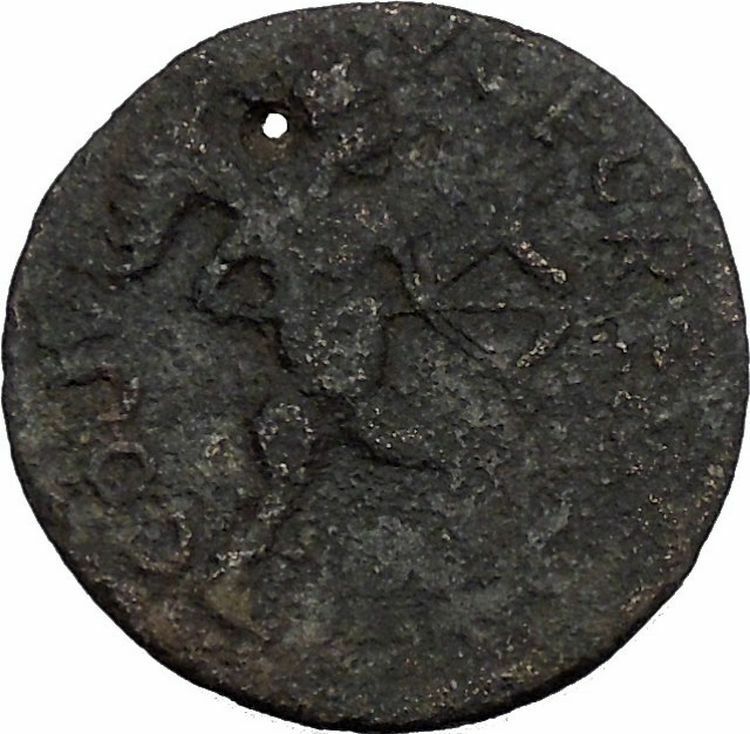|
Julia Domna – Roman Empress Wife of Emperor Septimius Severus 193-211 A.D. –
Bronze 17mm (3.60 grams) of Byzantion in Thrace
IOVΛIA AVΓ, Draped bust of Julia Domna right.
BYZANTIΩN, Crescent moon with star within.
You are bidding on the exact item pictured, provided with a Certificate of Authenticity and Lifetime Guarantee of Authenticity.
 Byzantium was the ancient Greek city on the site that later became Constantinople (modern Istanbul). It was founded by Greek colonists from Megara in 657 BC. The city was rebuilt and reinaugurated as the new capital of the Roman Empire by Emperor Constantine I in 330 AD and subsequently renamed Constantinople. The city remained the capital until 1453, when it was conquered and became the capital of the Ottoman Empire. Since the establishment of modern Turkey in 1923, the Turkish name of the city, Istanbul, has replaced the name Constantinople in the West. Byzantium was the ancient Greek city on the site that later became Constantinople (modern Istanbul). It was founded by Greek colonists from Megara in 657 BC. The city was rebuilt and reinaugurated as the new capital of the Roman Empire by Emperor Constantine I in 330 AD and subsequently renamed Constantinople. The city remained the capital until 1453, when it was conquered and became the capital of the Ottoman Empire. Since the establishment of modern Turkey in 1923, the Turkish name of the city, Istanbul, has replaced the name Constantinople in the West.
Name
The etymology of the Greek form Byzantion is unknown. In Greek legend it is said to be named after Byzas, the leader of the Megarean colonists and founder of the city. The name has been suggested as being of Thraco-Illyrian origin, perhaps indeed from a personal name Buzas. The form Byzantium is a Latinization of the Greek.
History
The origins of Byzantium are shrouded in legend. The traditional legend has it that Byzas from Megara (a city-state near Athens) founded Byzantium in 657 BC when he sailed northeast across the Aegean Sea. Byzas had consulted the Oracle at Delphi to ask where to found his new city. The Oracle told him to find it “opposite the blind”. At the time, he did not know what this meant, but when he came upon the Bosporus he understood: on the opposite eastern shore was a Greek city, Chalcedon, whose founders were said to have overlooked the superior location only 3 kilometres (1.9 mi) away. Byzas founded his city there on the European coast and named it Byzantium after himself. It was mainly a trading city due to its location at the Black Sea’s only entrance. Byzantium later conquered Chalcedon, across the Bosporus on the Asiatic side.
After siding with Pescennius Niger against the victorious Septimius Severus, the city was besieged by Roman forces and suffered extensive damage in 196 AD. Byzantium was rebuilt by Septimius Severus, now emperor, and quickly regained its previous prosperity. It was bound to Perinthos during the period of Septimius Severus. The location of Byzantium attracted Roman Emperor Constantine I who, in 330 AD, refounded it as an imperial residence inspired by Rome itself. (See Nova Roma.) After his death the city was called Constantinople (Greek Κωνσταντινούπολις or Konstantinoupolis) (“city of Constantine”).
This combination of imperialism and location would affect Constantinople’s role as the nexus between the continents of Europe and Asia. It was a commercial, cultural, and diplomatic centre. With its strategic position, Constantinople controlled the route between Asia and Europe, as well as the passage from the Mediterranean Sea to the Black Sea. On May 29, 1453, the city fell to the Ottoman Turks, and again became the capital of a powerful state, the Ottoman Empire. The Turks called the city “Istanbul” (although it was not officially renamed until 1930); the name derives from “eis-tin-polin” (Greek: “to-the-city”). To this day it remains the largest and most populous city in Turkey (the successor to the Ottoman Empire), although Ankara is now the national capital.
Emblem
Though associated with the Sassanid Persians and with Mithradates VI Eupator (who for a time incorporated the city into his empire), by the late Hellenistic or early Roman period, the star and crescent motif had been associated to some degree with Byzantium. For example, some Byzantine coins of the 1st century BC and later show the head of Artemis with bow and quiver, and feature a crescent with what appears to be a six-rayed star on the reverse. According to accounts which vary in some of the details, in 340 BC the Byzantines and their allies the Athenians were under siege by the troops of Philip of Macedon. On a particularly dark and wet night Philip attempted a surprise attack but was thwarted by the appearance of a bright light in the sky. This light is occasionally described by subsequent interpreters as a meteor, sometimes as the moon, and some accounts also mention the barking of dogs. However, the original accounts mention only a light in the sky, without specifying the moon. To commemorate the event the Byzantines erected a statue of Hecate lampadephoros (light-bearer or bringer). This story survived in the works of Hesychius of Miletus, who in all probability lived in the time of Justinian I. His works survive only in fragments preserved in Photius and the tenth century lexicographer Suidas. The tale is also related by Stephanus of Byzantium, and Eustathius.
Devotion to Hecate was especially favored by the Byzantines for her aid in having protected them from the incursions of Philip of Macedon. Her symbols were the crescent and star, and the walls of her city were her provenance.
It is unclear precisely how the symbol Hecate/Artemis, one of many goddesses would have been transferred to the city itself, but it seems likely to have been an effect of being credited with the intervention against Philip and the subsequent honors. This was a common process in ancient Greece, as in Athens where the city was named after Athena in honor of such an intervention in time of war.
Later, under the Romans, cities in the empire often continued to issue their own coinage. “Of the many themes that were used on local coinage, celestial and astral symbols often appeared, mostly stars or crescent moons.” The wide variety of these issues, and the varying explanations for the significance of the star and crescent on Roman coinage precludes their discussion here. It is, however, apparent that by the time of the Romans, coins featuring a star or crescent in some combination were not at all rare.
 Julia Domna – Augusta 193-217 A.D. Julia Domna – Augusta 193-217 A.D.
| Wife of Septimius Severus | Mother of Caracalla and Geta | Sister of Julia Maesa | Aunt of Julia Soaemias and Julia Mamaea | Great-aunt of Elagabalus and Severus Alexander | Mother-in-law of Plautilla |
Julia Domna, (Latin: Iulia Domna; c. 170 AD – 217 AD) was a member of the Severan dynasty of the Roman Empire. Empress and wife of Roman Emperor Lucius Septimius Severus and mother of Emperors Geta and Caracalla, Julia was famous for her prodigious learning as well as her extraordinary political influence.
Family background
Julia Domna was born in Emesa (known today as Homs) in Syria. She was the youngest daughter of the high-priest of Ba’al Gaius Julius Bassianus and sister to Julia Maesa, and she had two nieces: Julia Mamaea, mother of Severus Alexander, and Julia Soaemias, mother of Elagabalus. Her ancestors were Priest Kings of the famous temple of Elagabalus. The family had enormous wealth and was promoted to Roman senatorial aristocracy. Before her marriage, Julia inherited the estate of her paternal great-uncle Julius Agrippa, a former leading Centurion.
Reign
In the late 180s, Julia married future emperor Septimius Severus, usually considered to be of Punic background. They had two sons, Lucius Septimius Bassianus (Caracalla) in 188 and Publius Septimius Geta in 189. Because of her love of philosophy, Julia protected philosophers and helped philosophy to flourish in Rome. She was an imperial woman from 193-217 CE as wife to the emperor Septimius Severus and mother to emperors Geta (murdered by Caracalla in 211 CE) and Caracalla (r. 211-217 CE). Julia Domna died shortly after her son Caracalla was murdered.
Civil War or “Year of the Five Emperors”
After Commodus was murdered without an heir in 192 CE, many contenders rushed for the throne. An elder senator, Pertinax, was appointed by the praetorian guard. When Pertinax would not meet the guard’s demands of payment, his son-in-law Iulianus was called to Rome. After bribing the guard, Iulianus was appointed emperor, and Pertinax was murdered. Septimius Severus, coming from the north into Rome, overthrew Iulianus and had him executed. Septimius claimed the title of emperor in 193, and co-ruled Rome with Clodius Albinus until 195 CE when Septimius declared his sons AVGVSTVS, and defeated Albinus and his British legions. Septimius remained at war with an eastern rival to the throne, Niger, until he defeated Niger’s forces in 201 CE. Julia Domna and her sons accompanied Septimius in his campaigns in the East. During this time, titles were granted to Julia Domna reminiscent of titles given to Faustina the Younger, including MATER CASTORVM, or mother of the camp, MATER AVGVSTVS, mother of Augustus, and MATER PATRIAE, or mother of the fatherland.
Imperial Building Project: The aedes Vestae
The fire of Commodus in 192 CE destroyed areas of the aedes Vestae which includes the Temple of Vesta and the home, or Atrium, of the Vestal Virgins. Based on numismatic evidence, historical authors, and a laconic inscription found in situ, most scholars agree that Julia Domna funded restorations to the site during Septimius Severus’s reign.
Controversy and transition of power
As empress, Julia was often involved in intrigues and had plenty of political enemies, who accused her of treason and adultery. None of these accusations was proven. Severus continued to favour his wife and insisted on her company in the campaign against the Britons that started in 208. When Severus died in 211 in Eboracum (York), Julia became the mediator between their two sons, Caracalla and Geta, who were to rule as joint emperors, according to their father’s wishes expressed in his will. The two young men were never fond of each other and quarrelled frequently. Geta was murdered by Caracalla’s soldiers in the same year.
Caracalla was now sole emperor, but his relations with his mother were difficult, as attested by several sources, probably because of his involvement in Geta’s murder. Nevertheless, Julia accompanied Caracalla in his campaign against the Parthian empire in 217.
During this trip, Caracalla was assassinated and succeeded (briefly) by Macrinus. Julia chose to commit suicide after hearing about the rebellion, perhaps a decision hastened by the fact that she was suffering from breast cancer. Her body was brought to Rome and placed in the Sepulcrum C. et L. Caesaris (perhaps a separate chamber in the Mausoleum of Augustus). Later, however, both her bones and those of Geta were transferred by her sister Julia Maesa to the Mausoleum of Hadrian. She was later deified.
Apollonius
If it were not for Julia, there would have survived little information about the philosopher Apollonius of Tyana. It was at the behest of Julia that Philostratus wrote his now famous Life of Apollonius of Tyana. Julia is thought to have died before Philostratus could finish his work of eight volumes.
|





 Byzantium was the ancient Greek city on the site that later became Constantinople (modern Istanbul). It was founded by Greek colonists from Megara in 657 BC. The city was rebuilt and reinaugurated as the new capital of the Roman Empire by Emperor Constantine I in 330 AD and subsequently renamed Constantinople. The city remained the capital until 1453, when it was conquered and became the capital of the Ottoman Empire. Since the establishment of modern Turkey in 1923, the Turkish name of the city, Istanbul, has replaced the name Constantinople in the West.
Byzantium was the ancient Greek city on the site that later became Constantinople (modern Istanbul). It was founded by Greek colonists from Megara in 657 BC. The city was rebuilt and reinaugurated as the new capital of the Roman Empire by Emperor Constantine I in 330 AD and subsequently renamed Constantinople. The city remained the capital until 1453, when it was conquered and became the capital of the Ottoman Empire. Since the establishment of modern Turkey in 1923, the Turkish name of the city, Istanbul, has replaced the name Constantinople in the West. Julia Domna – Augusta 193-217 A.D.
Julia Domna – Augusta 193-217 A.D.




